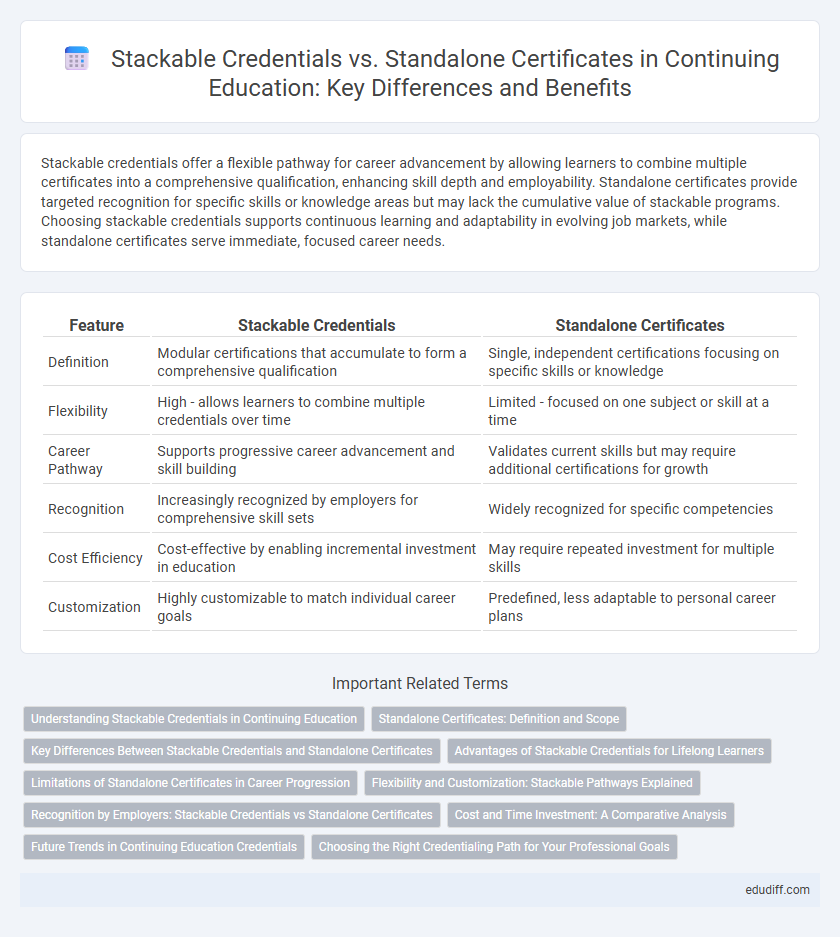Stackable credentials offer a flexible pathway for career advancement by allowing learners to combine multiple certificates into a comprehensive qualification, enhancing skill depth and employability. Standalone certificates provide targeted recognition for specific skills or knowledge areas but may lack the cumulative value of stackable programs. Choosing stackable credentials supports continuous learning and adaptability in evolving job markets, while standalone certificates serve immediate, focused career needs.
Table of Comparison
| Feature | Stackable Credentials | Standalone Certificates |
|---|---|---|
| Definition | Modular certifications that accumulate to form a comprehensive qualification | Single, independent certifications focusing on specific skills or knowledge |
| Flexibility | High - allows learners to combine multiple credentials over time | Limited - focused on one subject or skill at a time |
| Career Pathway | Supports progressive career advancement and skill building | Validates current skills but may require additional certifications for growth |
| Recognition | Increasingly recognized by employers for comprehensive skill sets | Widely recognized for specific competencies |
| Cost Efficiency | Cost-effective by enabling incremental investment in education | May require repeated investment for multiple skills |
| Customization | Highly customizable to match individual career goals | Predefined, less adaptable to personal career plans |
Understanding Stackable Credentials in Continuing Education
Stackable credentials in continuing education offer a flexible pathway for professionals to build specialized skills through a series of interconnected courses that accumulate into a comprehensive qualification. Unlike standalone certificates, stackable credentials enable learners to progressively earn credits that can be combined toward advanced certifications or degrees, fostering career advancement. This modular approach supports lifelong learning by aligning with industry demands and allowing customization based on individual goals.
Standalone Certificates: Definition and Scope
Standalone certificates are individual credentials awarded upon the completion of specific courses or training programs, validating a learner's mastery of defined skills or knowledge areas. These certificates typically cover focused topics and are designed to enhance professional qualifications without necessarily integrating into broader educational pathways. They provide targeted recognition for skills acquisition, often catering to immediate industry demands and career advancement opportunities.
Key Differences Between Stackable Credentials and Standalone Certificates
Stackable credentials consist of multiple, linked certifications that build progressively toward a comprehensive qualification or degree, enhancing career flexibility and lifelong learning opportunities. Standalone certificates, by contrast, represent a single skill or competency, offering immediate job-specific knowledge but limited in scope for further educational advancement. Key differences include stackable credentials' modular structure versus the fixed achievement of standalone certificates, impacting how learners accumulate skills and how employers assess qualifications.
Advantages of Stackable Credentials for Lifelong Learners
Stackable credentials offer lifelong learners flexible pathways to build comprehensive skill sets by accumulating smaller, recognized qualifications that can be combined into advanced certifications or degrees. These modular credentials enhance career adaptability by allowing learners to update and expand their expertise incrementally without starting from scratch. Employers increasingly value stackable credentials for their demonstrated commitment to continuous learning and relevant, up-to-date skills across multiple disciplines.
Limitations of Standalone Certificates in Career Progression
Standalone certificates often lack the flexibility and comprehensive skill validation that stackable credentials offer, limiting their effectiveness in career progression. They typically focus on a narrow set of skills, making it difficult for professionals to demonstrate continuous learning or adaptability to evolving job market demands. Employers increasingly favor stackable credentials for their ability to showcase progressive skill acquisition, which standalone certificates cannot provide.
Flexibility and Customization: Stackable Pathways Explained
Stackable credentials provide unmatched flexibility by allowing learners to accumulate credits across multiple courses and institutions, tailoring their education to specific career goals. These pathways enable customization through modular learning units that build progressively, enhancing skill sets over time. In contrast, standalone certificates offer fixed content with limited adaptability, restricting opportunities for ongoing professional development.
Recognition by Employers: Stackable Credentials vs Standalone Certificates
Employers increasingly value stackable credentials for their ability to demonstrate a progressive acquisition of skills and competencies tailored to evolving job market demands. Standalone certificates provide proof of expertise in a specific area but may lack the comprehensive skill validation that stackable credentials offer through cumulative achievement. Recognition by employers tends to favor stackable credentials due to their alignment with career pathways and potential for continuous professional development.
Cost and Time Investment: A Comparative Analysis
Stackable credentials often require a longer time investment but provide cumulative value, reducing overall training costs by enabling learners to build upon previously earned certifications. Standalone certificates typically demand a shorter time commitment but might result in higher total expenses due to lack of credit transferability. Investing in stackable credentials can enhance cost-efficiency and streamline the educational pathway for professionals seeking continuous skill development.
Future Trends in Continuing Education Credentials
Stackable credentials are shaping the future of continuing education by enabling learners to accumulate credits over time, leading to comprehensive qualifications tailored to evolving career demands. Increasing integration of digital badges and microcredentials reflects a shift towards modular learning pathways that offer flexibility and recognition in diverse industries. Advances in AI-driven personalized learning platforms will enhance the seamless stacking of credentials, promoting lifelong skill development and professional adaptability.
Choosing the Right Credentialing Path for Your Professional Goals
Evaluating your professional goals and industry demands is crucial when choosing between stackable credentials and standalone certificates. Stackable credentials offer a flexible, cumulative learning path that can adapt to evolving career objectives and enhance long-term employability. Standalone certificates provide targeted skill validation ideal for immediate job requirements or specific expertise development.
Stackable Credentials vs Standalone Certificates Infographic

 edudiff.com
edudiff.com